Nursing: Evidence-Based Practice Report on Pressure Ulcer Analysis
VerifiedAdded on 2023/01/18
|5
|1098
|78
Report
AI Summary
This report focuses on the evidence-based practice (EBP) approach to address the problem of pressure ulcers, particularly in older patients. It begins by identifying the clinical problem and the need for improved interventions beyond standard mattresses. The report then explains the PICOT (Population, Intervention, Comparison, Outcome, Time) framework as a crucial tool for formulating research questions in healthcare, emphasizing how each component helps define the scope of the study and identify effective treatment options. The core of the report formulates a PICOT question concerning the use of pressure-relieving mattresses to reduce the incidence of pressure ulcers in older, immobile patients, and provides a comprehensive overview of the benefits of pressure-relieving mattresses, including their design and function in distributing pressure and preventing tissue damage. The report concludes by highlighting the importance of alternating pressure mattresses for high-risk individuals and provides references to support the findings.
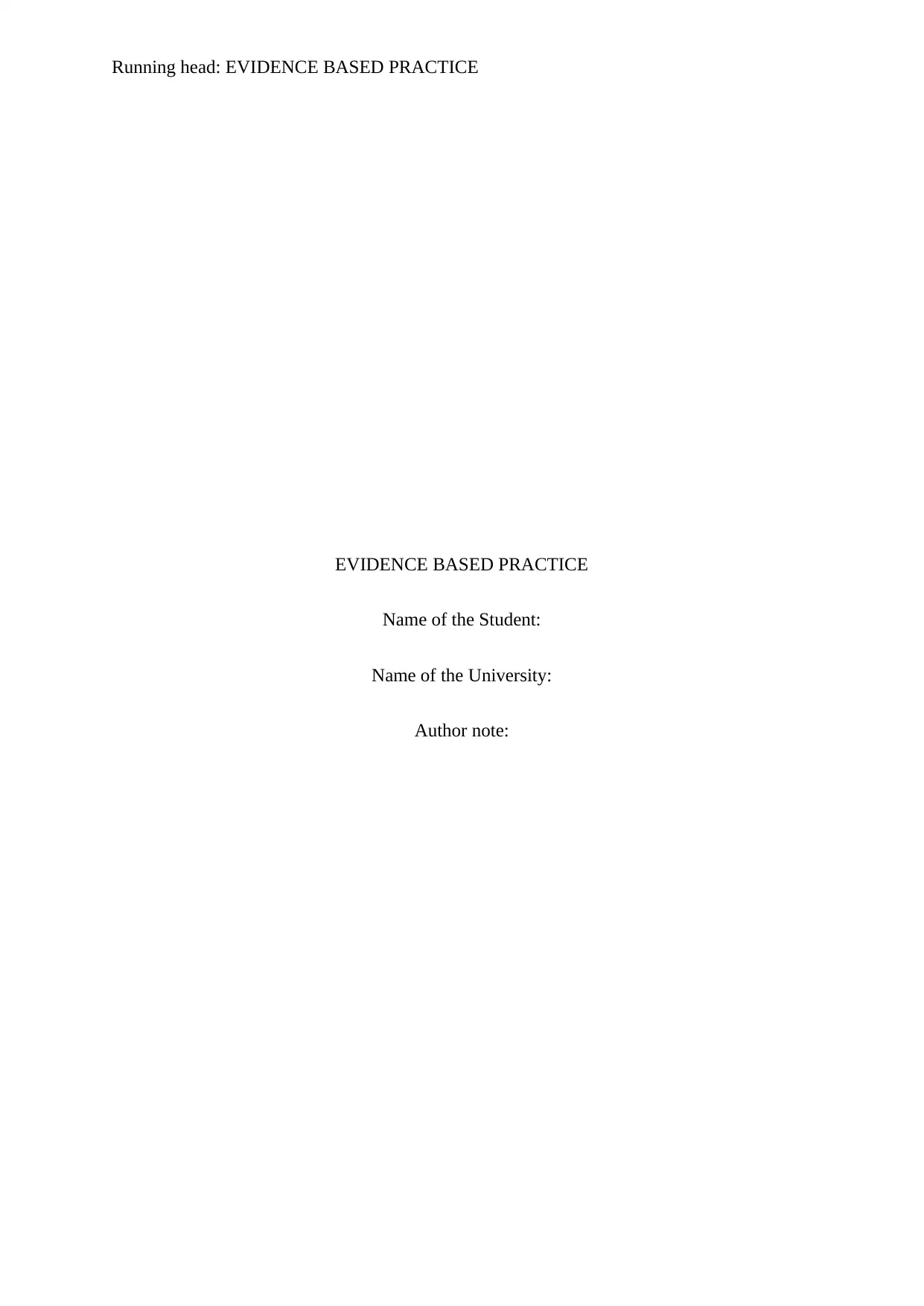
Running head: EVIDENCE BASED PRACTICE
EVIDENCE BASED PRACTICE
Name of the Student:
Name of the University:
Author note:
EVIDENCE BASED PRACTICE
Name of the Student:
Name of the University:
Author note:
Paraphrase This Document
Need a fresh take? Get an instant paraphrase of this document with our AI Paraphraser
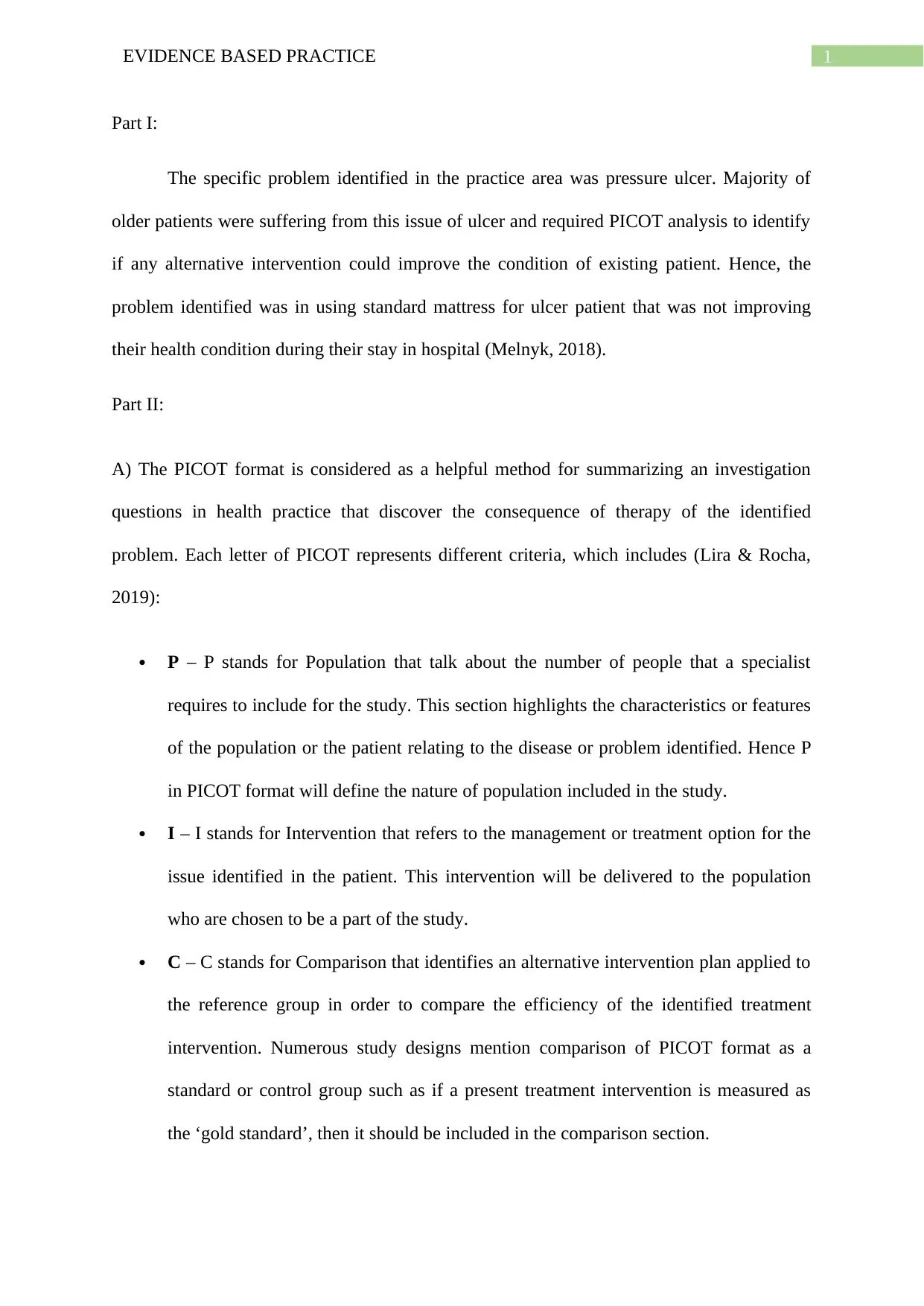
1EVIDENCE BASED PRACTICE
Part I:
The specific problem identified in the practice area was pressure ulcer. Majority of
older patients were suffering from this issue of ulcer and required PICOT analysis to identify
if any alternative intervention could improve the condition of existing patient. Hence, the
problem identified was in using standard mattress for ulcer patient that was not improving
their health condition during their stay in hospital (Melnyk, 2018).
Part II:
A) The PICOT format is considered as a helpful method for summarizing an investigation
questions in health practice that discover the consequence of therapy of the identified
problem. Each letter of PICOT represents different criteria, which includes (Lira & Rocha,
2019):
P – P stands for Population that talk about the number of people that a specialist
requires to include for the study. This section highlights the characteristics or features
of the population or the patient relating to the disease or problem identified. Hence P
in PICOT format will define the nature of population included in the study.
I – I stands for Intervention that refers to the management or treatment option for the
issue identified in the patient. This intervention will be delivered to the population
who are chosen to be a part of the study.
C – C stands for Comparison that identifies an alternative intervention plan applied to
the reference group in order to compare the efficiency of the identified treatment
intervention. Numerous study designs mention comparison of PICOT format as a
standard or control group such as if a present treatment intervention is measured as
the ‘gold standard’, then it should be included in the comparison section.
Part I:
The specific problem identified in the practice area was pressure ulcer. Majority of
older patients were suffering from this issue of ulcer and required PICOT analysis to identify
if any alternative intervention could improve the condition of existing patient. Hence, the
problem identified was in using standard mattress for ulcer patient that was not improving
their health condition during their stay in hospital (Melnyk, 2018).
Part II:
A) The PICOT format is considered as a helpful method for summarizing an investigation
questions in health practice that discover the consequence of therapy of the identified
problem. Each letter of PICOT represents different criteria, which includes (Lira & Rocha,
2019):
P – P stands for Population that talk about the number of people that a specialist
requires to include for the study. This section highlights the characteristics or features
of the population or the patient relating to the disease or problem identified. Hence P
in PICOT format will define the nature of population included in the study.
I – I stands for Intervention that refers to the management or treatment option for the
issue identified in the patient. This intervention will be delivered to the population
who are chosen to be a part of the study.
C – C stands for Comparison that identifies an alternative intervention plan applied to
the reference group in order to compare the efficiency of the identified treatment
intervention. Numerous study designs mention comparison of PICOT format as a
standard or control group such as if a present treatment intervention is measured as
the ‘gold standard’, then it should be included in the comparison section.
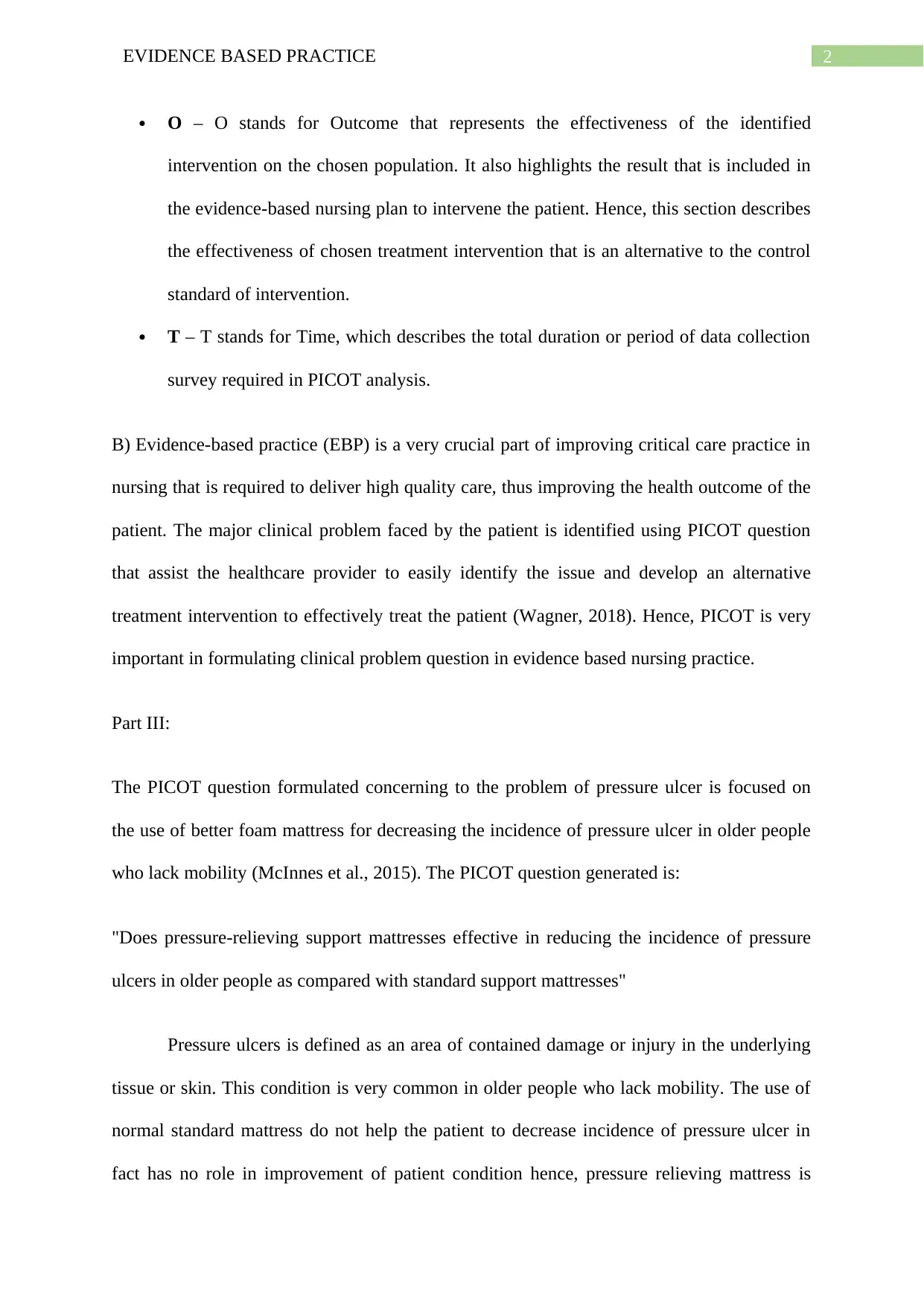
2EVIDENCE BASED PRACTICE
O – O stands for Outcome that represents the effectiveness of the identified
intervention on the chosen population. It also highlights the result that is included in
the evidence-based nursing plan to intervene the patient. Hence, this section describes
the effectiveness of chosen treatment intervention that is an alternative to the control
standard of intervention.
T – T stands for Time, which describes the total duration or period of data collection
survey required in PICOT analysis.
B) Evidence-based practice (EBP) is a very crucial part of improving critical care practice in
nursing that is required to deliver high quality care, thus improving the health outcome of the
patient. The major clinical problem faced by the patient is identified using PICOT question
that assist the healthcare provider to easily identify the issue and develop an alternative
treatment intervention to effectively treat the patient (Wagner, 2018). Hence, PICOT is very
important in formulating clinical problem question in evidence based nursing practice.
Part III:
The PICOT question formulated concerning to the problem of pressure ulcer is focused on
the use of better foam mattress for decreasing the incidence of pressure ulcer in older people
who lack mobility (McInnes et al., 2015). The PICOT question generated is:
"Does pressure-relieving support mattresses effective in reducing the incidence of pressure
ulcers in older people as compared with standard support mattresses"
Pressure ulcers is defined as an area of contained damage or injury in the underlying
tissue or skin. This condition is very common in older people who lack mobility. The use of
normal standard mattress do not help the patient to decrease incidence of pressure ulcer in
fact has no role in improvement of patient condition hence, pressure relieving mattress is
O – O stands for Outcome that represents the effectiveness of the identified
intervention on the chosen population. It also highlights the result that is included in
the evidence-based nursing plan to intervene the patient. Hence, this section describes
the effectiveness of chosen treatment intervention that is an alternative to the control
standard of intervention.
T – T stands for Time, which describes the total duration or period of data collection
survey required in PICOT analysis.
B) Evidence-based practice (EBP) is a very crucial part of improving critical care practice in
nursing that is required to deliver high quality care, thus improving the health outcome of the
patient. The major clinical problem faced by the patient is identified using PICOT question
that assist the healthcare provider to easily identify the issue and develop an alternative
treatment intervention to effectively treat the patient (Wagner, 2018). Hence, PICOT is very
important in formulating clinical problem question in evidence based nursing practice.
Part III:
The PICOT question formulated concerning to the problem of pressure ulcer is focused on
the use of better foam mattress for decreasing the incidence of pressure ulcer in older people
who lack mobility (McInnes et al., 2015). The PICOT question generated is:
"Does pressure-relieving support mattresses effective in reducing the incidence of pressure
ulcers in older people as compared with standard support mattresses"
Pressure ulcers is defined as an area of contained damage or injury in the underlying
tissue or skin. This condition is very common in older people who lack mobility. The use of
normal standard mattress do not help the patient to decrease incidence of pressure ulcer in
fact has no role in improvement of patient condition hence, pressure relieving mattress is
⊘ This is a preview!⊘
Do you want full access?
Subscribe today to unlock all pages.

Trusted by 1+ million students worldwide
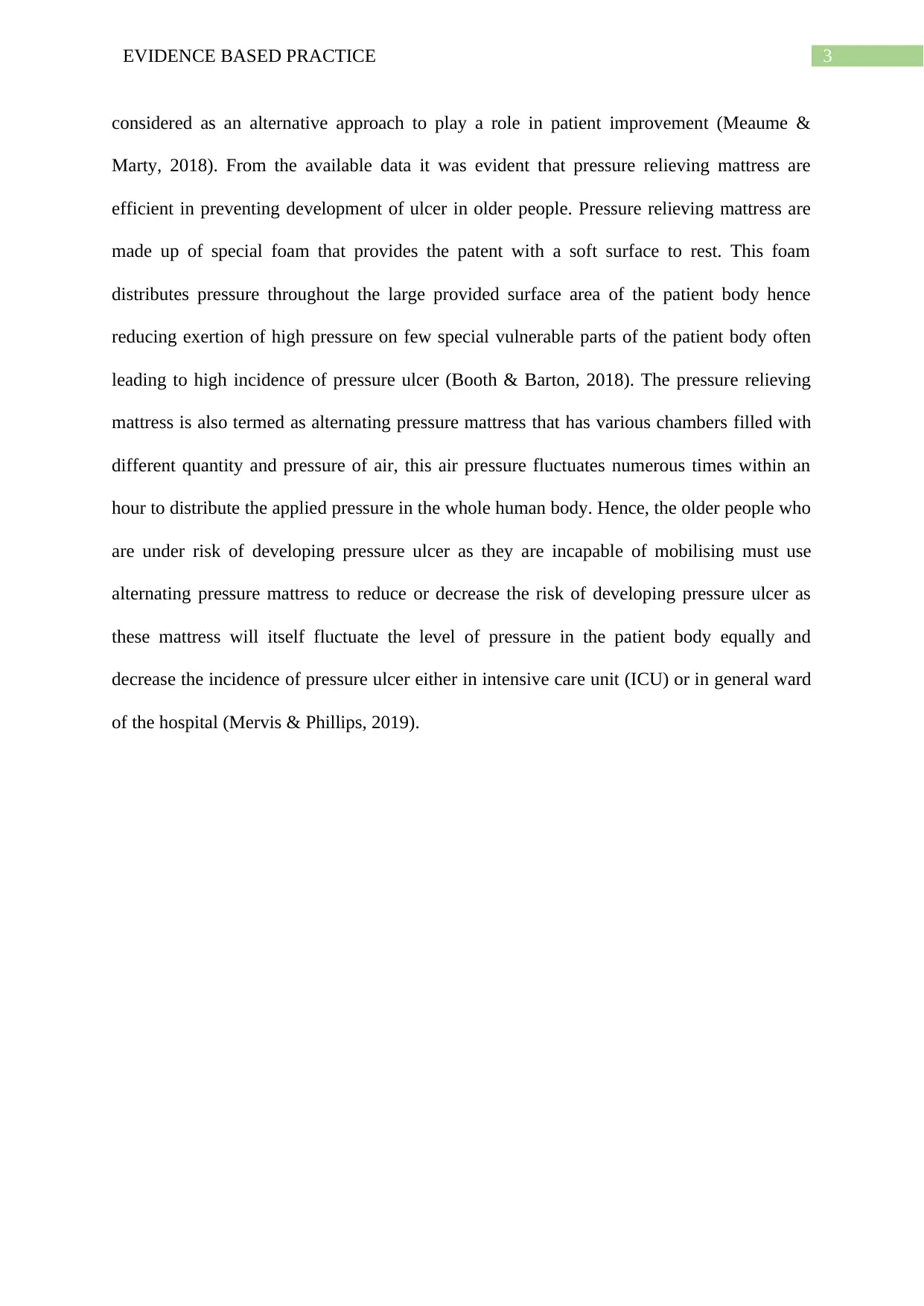
3EVIDENCE BASED PRACTICE
considered as an alternative approach to play a role in patient improvement (Meaume &
Marty, 2018). From the available data it was evident that pressure relieving mattress are
efficient in preventing development of ulcer in older people. Pressure relieving mattress are
made up of special foam that provides the patent with a soft surface to rest. This foam
distributes pressure throughout the large provided surface area of the patient body hence
reducing exertion of high pressure on few special vulnerable parts of the patient body often
leading to high incidence of pressure ulcer (Booth & Barton, 2018). The pressure relieving
mattress is also termed as alternating pressure mattress that has various chambers filled with
different quantity and pressure of air, this air pressure fluctuates numerous times within an
hour to distribute the applied pressure in the whole human body. Hence, the older people who
are under risk of developing pressure ulcer as they are incapable of mobilising must use
alternating pressure mattress to reduce or decrease the risk of developing pressure ulcer as
these mattress will itself fluctuate the level of pressure in the patient body equally and
decrease the incidence of pressure ulcer either in intensive care unit (ICU) or in general ward
of the hospital (Mervis & Phillips, 2019).
considered as an alternative approach to play a role in patient improvement (Meaume &
Marty, 2018). From the available data it was evident that pressure relieving mattress are
efficient in preventing development of ulcer in older people. Pressure relieving mattress are
made up of special foam that provides the patent with a soft surface to rest. This foam
distributes pressure throughout the large provided surface area of the patient body hence
reducing exertion of high pressure on few special vulnerable parts of the patient body often
leading to high incidence of pressure ulcer (Booth & Barton, 2018). The pressure relieving
mattress is also termed as alternating pressure mattress that has various chambers filled with
different quantity and pressure of air, this air pressure fluctuates numerous times within an
hour to distribute the applied pressure in the whole human body. Hence, the older people who
are under risk of developing pressure ulcer as they are incapable of mobilising must use
alternating pressure mattress to reduce or decrease the risk of developing pressure ulcer as
these mattress will itself fluctuate the level of pressure in the patient body equally and
decrease the incidence of pressure ulcer either in intensive care unit (ICU) or in general ward
of the hospital (Mervis & Phillips, 2019).
Paraphrase This Document
Need a fresh take? Get an instant paraphrase of this document with our AI Paraphraser
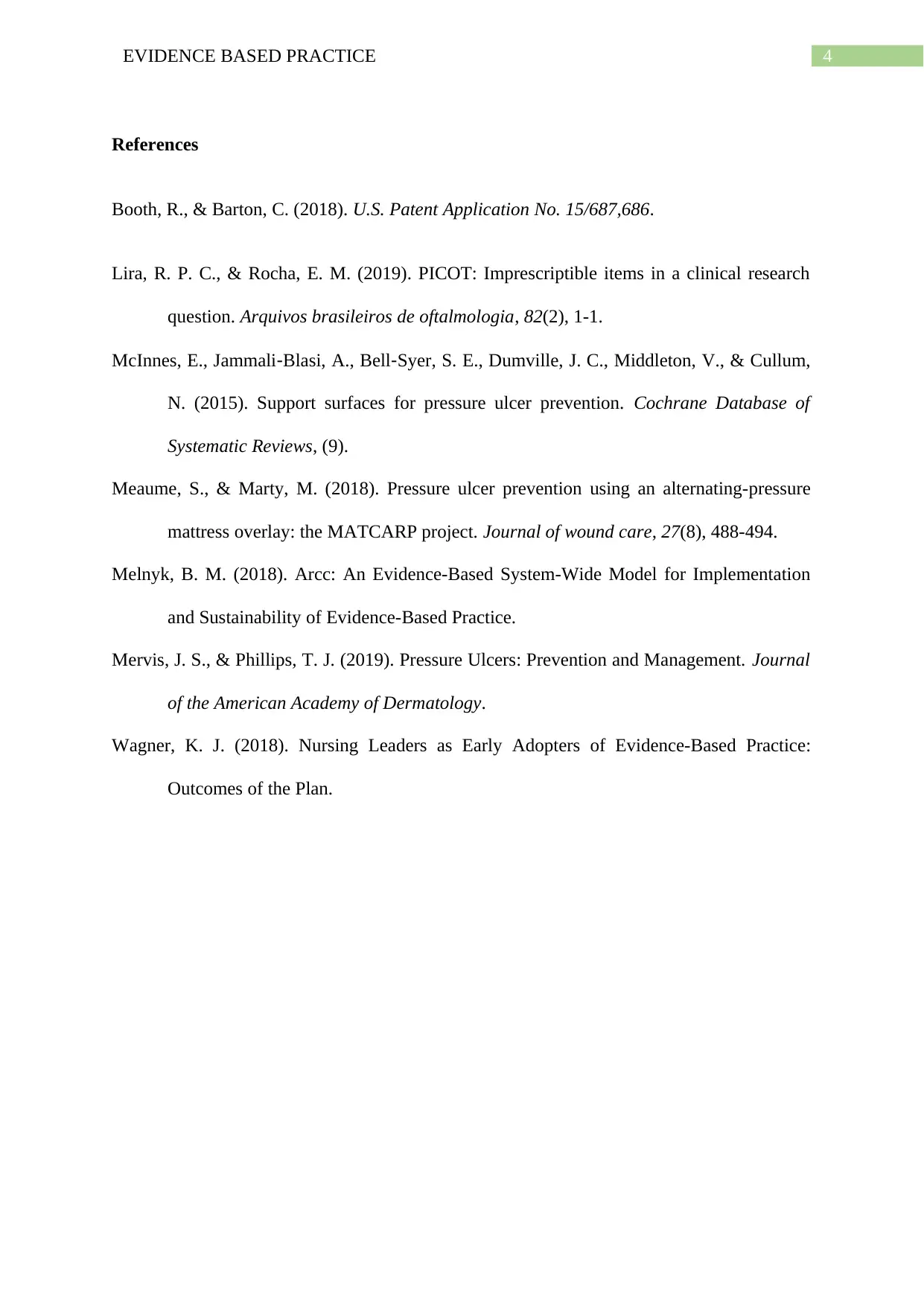
4EVIDENCE BASED PRACTICE
References
Booth, R., & Barton, C. (2018). U.S. Patent Application No. 15/687,686.
Lira, R. P. C., & Rocha, E. M. (2019). PICOT: Imprescriptible items in a clinical research
question. Arquivos brasileiros de oftalmologia, 82(2), 1-1.
McInnes, E., Jammali‐Blasi, A., Bell‐Syer, S. E., Dumville, J. C., Middleton, V., & Cullum,
N. (2015). Support surfaces for pressure ulcer prevention. Cochrane Database of
Systematic Reviews, (9).
Meaume, S., & Marty, M. (2018). Pressure ulcer prevention using an alternating-pressure
mattress overlay: the MATCARP project. Journal of wound care, 27(8), 488-494.
Melnyk, B. M. (2018). Arcc: An Evidence-Based System-Wide Model for Implementation
and Sustainability of Evidence-Based Practice.
Mervis, J. S., & Phillips, T. J. (2019). Pressure Ulcers: Prevention and Management. Journal
of the American Academy of Dermatology.
Wagner, K. J. (2018). Nursing Leaders as Early Adopters of Evidence-Based Practice:
Outcomes of the Plan.
References
Booth, R., & Barton, C. (2018). U.S. Patent Application No. 15/687,686.
Lira, R. P. C., & Rocha, E. M. (2019). PICOT: Imprescriptible items in a clinical research
question. Arquivos brasileiros de oftalmologia, 82(2), 1-1.
McInnes, E., Jammali‐Blasi, A., Bell‐Syer, S. E., Dumville, J. C., Middleton, V., & Cullum,
N. (2015). Support surfaces for pressure ulcer prevention. Cochrane Database of
Systematic Reviews, (9).
Meaume, S., & Marty, M. (2018). Pressure ulcer prevention using an alternating-pressure
mattress overlay: the MATCARP project. Journal of wound care, 27(8), 488-494.
Melnyk, B. M. (2018). Arcc: An Evidence-Based System-Wide Model for Implementation
and Sustainability of Evidence-Based Practice.
Mervis, J. S., & Phillips, T. J. (2019). Pressure Ulcers: Prevention and Management. Journal
of the American Academy of Dermatology.
Wagner, K. J. (2018). Nursing Leaders as Early Adopters of Evidence-Based Practice:
Outcomes of the Plan.
1 out of 5
Related Documents
Your All-in-One AI-Powered Toolkit for Academic Success.
+13062052269
info@desklib.com
Available 24*7 on WhatsApp / Email
![[object Object]](/_next/static/media/star-bottom.7253800d.svg)
Unlock your academic potential
Copyright © 2020–2025 A2Z Services. All Rights Reserved. Developed and managed by ZUCOL.





